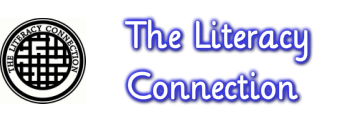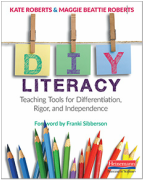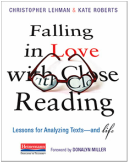DIY Literacy: Creating and Using
Teaching Tools to Help Students
(Happily) Hold Onto Teaching and
Work to Their Fullest
Grades K-8
Kate's Focus for General Sessions: Chances are, you are working harder than ever before. Your units are chock-full of powerful lessons that push kids to higher and higher standards of learning. Often our students encounter all of this teaching without always knowing how to hold on to and use it over time. Over the course of two days, Kate will introduce a few powerful tools to help students recall and use what has been taught, push themselves to work harder and more effectively, and to find themselves within a packed curriculum. Of course, tools are only as good as the level to which they are used, so Kate will also demonstrate some impactful ways to introduce and use these tools in our everyday work. This will be a fast-paced, interactive class, and participants should expect to walk away with a variety of tools to help solve some of the most pernicious problems we face when helping students learn.
REGISTRATION: Click on the Study Group page for information on registering for any of the sessions. Total program cost for 4 sessions is $150. Ashland University credit of one semester hour is available for those who join the study group for our 4 session program. Cost of credit hour 2015-2016 was $175. We will need to find out if Ashland will change their fee next school year.
About Kate: Growing up, Kate Roberts swore to never become a writer or a teacher. She became both and is very grateful that fate did not listen. Kate is coauthor (with Maggie Beattie Roberts) of DIY Literacy and of Falling in Love with Close Reading (with Christopher Lehman) . Each is informed by her experiences as a middle school language arts teacher in Brooklyn, as a literacy coach, and, currently, as a staff developer with the Teachers College Reading and Writing Project. Her work with students across the country has led her to believe that all kids can be insightful, academic thinkers when the work is demystified, broken down, and made engaging. To this end, she has worked nationally and internationally to help teachers, schools, and districts develop and implement strong teaching practices and curriculum. Kate is the author of two produced plays, one undiscovered young adult novel, and coauthor of the blog “indent” (kateandmaggie.com). She lives in the same Brooklyn neighborhood she taught in so that she can keep tabs on her old students.
From the Heinemann website
From the Heinemann website
|
|
This Year's Study Book: DIY Literacy: Teaching Tools for Differentiation, Rigor, and Independence By Kate Roberts, Maggie Beattie Roberts “We have never seen teachers work harder than we do now. These tools inspire kids to work as hard as we are.” —Kate Roberts and Maggie Beattie Roberts What’s DIY Literacy? It’s making your own visual teaching tools instead of buying them. It’s using your teaching smarts to get the most from those tools. And it’s helping kids think strategically so they can be DIY learners. “Teaching tools create an impact on students’ learning,” write Kate Roberts and Maggie Beattie Roberts. “They help students hold onto our teaching and become changed by the work in the classroom.” Of course, you and your students need the right tools for the job, so first Kate and Maggie share four simple, visual tools that you can make. Then they show how to maximize your instructional know-how with suggestions for using the tools to:
Kate and Maggie are like a friendly, handy neighbor. They offer experience-honed advice for using the four tools for assessment, small-group instruction, conferring, setting learning goals, and, most important, helping students learn to apply strategies and make progress without prompting from you. In other words, to do it themselves. “It is our greatest hope,” write Kate and Maggie, “that the tools we offer here will help your students to work hard, to hold onto what they know, and to see themselves in the curriculum you teach.” Try DIY Literacy and help your readers and writers take learning into their own hands. From the Heinemann website |
Kate and Maggie's Blog
|
Falling in Love with Close Reading: Lessons for Analyzing Texts – And Life by Chris Lehman and Kate Roberts
"Love brings us in close, leads us to study the details of a thing, and asks us to return again and again. These are the motivations and ideas that built this book." —Chris Lehman and Kate Roberts You and your students will fall for close reading. In Falling in Love with Close Reading, Christopher Lehman and Kate Roberts show us that it can be rigorous, meaningful, and joyous. You’ll empower students to not only analyze texts but to admire the craft of a beloved book, study favorite songs and videogames, and challenge peers in evidence-based discussions. Chris and Kate start with a powerful three-step close-reading ritual that students can apply to any text. Then they lay out practical, engaging lessons that not only guide students to independence in reading texts closely but also help them transfer this critical, analytical skill to media and even the lives they lead. Responsive to students’ needs and field-tested in classrooms, these lessons include:
“We see the ritual of close reading not just as a method of doing the academic work of looking closely at text-evidence, word choice, and structure,” write Chris and Kate, “but as an opportunity to bring those practices together to empower our students to see the subtle messages in texts and in their lives.” Read Falling in Love with Close Reading and discover that the benefits and joy of close reading don’t have to stop at the edge of the page. Read a sample from the book to learn more about Chris and Kate's close-reading ritual for students and for an annotated text that shows how it works. From the Heinemann website |



